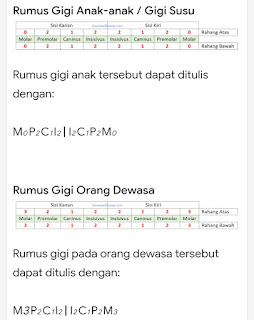Structure, Anatomy, Functions and Formulas of Human Teeth
The teeth are composed of three parts, namely the crown of the tooth (corona), the neck of the tooth (corum), and the root of the tooth (radius). The root of the tooth is the part of the tooth inside the jaw of the tooth. Tooth formation begins with two embryonal tissues, namely ectoderm and mesoderm.
The ectoderm will form the outermost layer of teeth or email. Email is a hard layer that is useful for covering the surface of the teeth. Email has a function as protective teeth when chewing. Email is also able to protect teeth against acidic conditions that can dissolve dentine.
Meanwhile, mesoderm will form dentin (dental bone) which is in the e-mail, cementum (outer layer of tooth root), and pulp (tooth cavity) which contains many nerve fibers and blood vessels.
Based on the shape, the teeth possessed by humans consist of incisors, canines, and front molars (premolar) and rear molars (molar). The incisors function to cut food. Canines function to tear food. Molar teeth function to chew food.
Teething in humans through two stages, namely the milk teeth (deciduous) and permanent teeth. Milk teeth grow when the growth period occurs in infants ranging in age from 6-7 months to 26 months of age. After six to fourteen years of age, the baby teeth will be replaced with permanent teeth.
The number of teeth in children is 20. In the maxilla and lower jaw there are 8 incisors (2 x 4), 4 canines 14 x (1 x 1)], and 8 molars [2 x (2 x 2)]. While in adults it is added with 12 rear molars 12 x (3 + 3)], so the number of teeth will be 32 pieces. To make it easier to find out the arrangement and number of teeth, there is a dental formula which is explained in the form of the following diagram:


Post a Comment